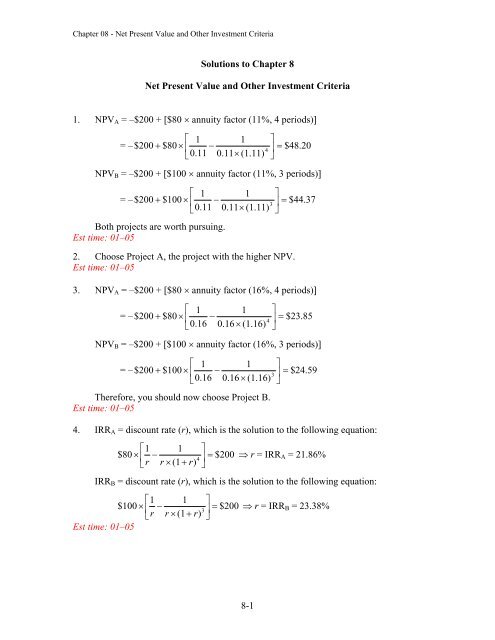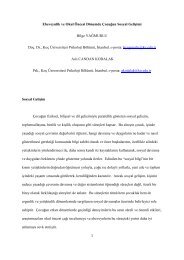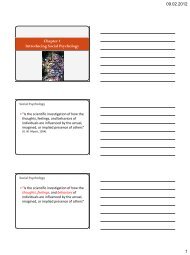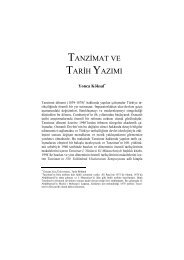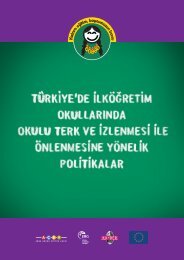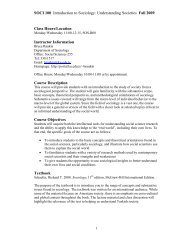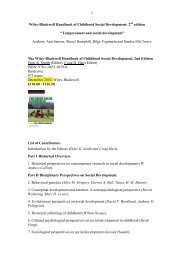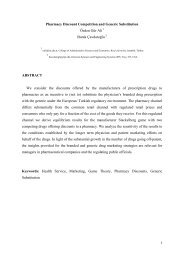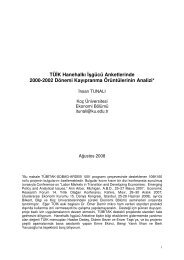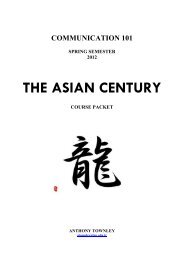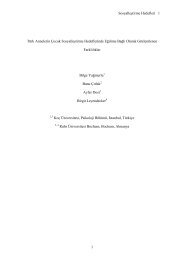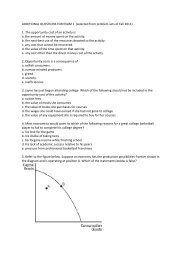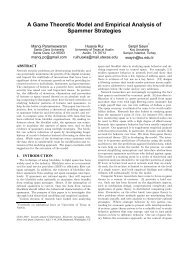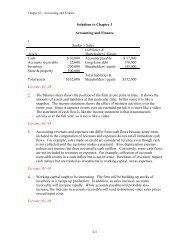8-1 Solutions to Chapter 8 Net Present Value and Other Investment ...
8-1 Solutions to Chapter 8 Net Present Value and Other Investment ...
8-1 Solutions to Chapter 8 Net Present Value and Other Investment ...
- No tags were found...
Create successful ePaper yourself
Turn your PDF publications into a flip-book with our unique Google optimized e-Paper software.
<strong>Chapter</strong> 08 - <strong>Net</strong> <strong>Present</strong> <strong>Value</strong> <strong>and</strong> <strong>Other</strong> <strong>Investment</strong> Criteria<strong>Solutions</strong> <strong>to</strong> <strong>Chapter</strong> 8<strong>Net</strong> <strong>Present</strong> <strong>Value</strong> <strong>and</strong> <strong>Other</strong> <strong>Investment</strong> Criteria1. NPV A = –$200 + [$80 annuity fac<strong>to</strong>r (11%, 4 periods)] 1 1 = – $200 $80 $48. 204 0.110.11(1.11) NPV B = –$200 + [$100 annuity fac<strong>to</strong>r (11%, 3 periods)] 1 1 = – $200 $100 $44. 373 0.110.11(1.11) Both projects are worth pursuing.Est time: 01–052. Choose Project A, the project with the higher NPV.Est time: 01–053. NPV A = –$200 + [$80 annuity fac<strong>to</strong>r (16%, 4 periods)] 1 1 = – $200 $80 $23. 854 0.160.16(1.16) NPV B = –$200 + [$100 annuity fac<strong>to</strong>r (16%, 3 periods)] 1 1 = – $200 $100 $24. 593 0.160.16 (1.16) Therefore, you should now choose Project B.Est time: 01–054. IRR A = discount rate (r), which is the solution <strong>to</strong> the following equation:11 $80 $2004(1 ) r = IRR A = 21.86%rr r IRR B = discount rate (r), which is the solution <strong>to</strong> the following equation:11 $100 $2003(1 )rr r Est time: 01–05 r = IRR B = 23.38%8-1
<strong>Chapter</strong> 08 - <strong>Net</strong> <strong>Present</strong> <strong>Value</strong> <strong>and</strong> <strong>Other</strong> <strong>Investment</strong> Criteria5. No. Even though project B has the higher IRR, its NPV is lower than that of project Awhen the discount rate is lower (as in Problem 1) <strong>and</strong> higher when the discount rate ishigher (as in Problem 3). This example shows that the project with the higher IRR isnot necessarily better. The IRR of each project is fixed, but as the discount rateincreases, project B becomes relatively more attractive compared <strong>to</strong> project A. This isbecause B’s cash flows come earlier, so the present value of these cash flows decreasesless rapidly when the discount rate increases.Est time: 01–056. The profitability indexes are as follows:Project A: $48.20/$200 = 0.2410Project B: $44.37/$200 = 0.2219In this case, with equal initial investments, both the profitability index <strong>and</strong> NPVgive projects the same ranking. This is an unusual case, however, since it is rare forthe initial investments <strong>to</strong> be equal.Est time: 01–057. Project A has a payback period of $200/$80 = 2.5 years.Project B has a payback period of 2 years.Est time: 01–058. No. Despite its longer payback period, Project A may still be the preferred project,for example, when the discount rate is 11% (as in Problems 1 <strong>and</strong> 2). As inProblem 5, you should note that the payback period for each project is fixed but theNPV changes as the discount rate changes. The project with the shorter paybackperiod need not have the higher NPV.Est time: 01–058-2
<strong>Chapter</strong> 08 - <strong>Net</strong> <strong>Present</strong> <strong>Value</strong> <strong>and</strong> <strong>Other</strong> <strong>Investment</strong> Criteria9. NPV = $3,000 + [$800 annuity fac<strong>to</strong>r (10%, 6 years)] 1 1 = – $3,000 $800 $484. 216 0.100.10(1.10) At the 10% discount rate, the project is worth pursuing.IRR = discount rate (r), which is the solution <strong>to</strong> the following equation:11 $800 $3,0006(1 ) r = IRR = 15.34%rr r You can solve for IRR using a financial calcula<strong>to</strong>r by entering PV = ()3,000; n = 6;FV = 0; PMT = 800; then compute i.Since the IRR is 15.34%, this is the highest discount rate before project NPVturns negative.Est time: 01–0510. Payback period = $2,500/$600 = 4.167 yearsThis is less than the cu<strong>to</strong>ff, so the firm would accept the project.r = 2% NPV = $2,500 + [$600 annuity fac<strong>to</strong>r (2%, 6 years)] 1 1 = – $2,500 $600 $860. 866 0.020.02(1.02) r = 12% NPV = $2,500 + [$600 annuity fac<strong>to</strong>r (12%, 6 years)] 1 1 = – $2,500 $600 $33.166 0.120.12 (1.12) If r = 2%, the project should be pursued; at r = 12%, it should not be.Est time: 06–10$3,000 $3,000 $5,000 $5,00011. NPV $10,000 $2,680. 382 341.09 1.09 1.09 1.09Profitability index = NPV/investment = 0.2680Est time: 01–058-3
<strong>Chapter</strong> 08 - <strong>Net</strong> <strong>Present</strong> <strong>Value</strong> <strong>and</strong> <strong>Other</strong> <strong>Investment</strong> Criteria12. NPV = $2.2 billion + [$0.3 billion annuity fac<strong>to</strong>r (r, 15 years)] [$0.9 billion/(1 + r) 15 ]11 $0.9 billion= – $2.2 billion $0.3billion 1515r r (1 r) (1r)r = 5% NPV = $2.2 billion + $2.681 billion = $0.481 billionr = 18% NPV = $2.2 billion + $1.452 billion = $0.748 billionEst time: 01–0513. IRR A = discount rate (r), which is the solution <strong>to</strong> the following equation:11 $21,000 $30,0002(1 ) r = IRR A = 25.69%rr r IRR B = discount rate (r), which is the solution <strong>to</strong> the following equation:11 $33,000 $50,0002(1 ) r = IRR B = 20.69%rr r The IRR of project A is 25.69%, <strong>and</strong> that of B is 20.69%. However, project B hasthe higher NPV <strong>and</strong> therefore is preferred. The incremental cash flows of B over Aare $20,000 at time 0 <strong>and</strong> +$12,000 at times 1 <strong>and</strong> 2. The NPV of the incrementalcash flows (discounted at 10%) is $826.45, which is positive <strong>and</strong> equal <strong>to</strong> thedifference in the respective project NPVs.Est time: 01–05$4,000 $11,00014. NPV $5,000 $197.7021.12 (1.12)Because the NPV is negative, you should reject the offer. You should reject theoffer despite the fact that the IRR exceeds the discount rate. This is a “borrowingtype”project with positive cash flows followed by negative cash flows. A highIRR in these cases is not attractive: You don’t want <strong>to</strong> borrow at a high interest rate.Est time: 01–0515. a. r = 0% NPV = –$6,750 + $4,500 + $18,000 = $15,750$4,500 $18,000r = 50% NPV= $ 6,750 $4, 25021.50 1.50$4,500 $18,000r = 100% NPV= $ 6,750 $ 022.00 2.00b. IRR = 100%, the discount rate at which NPV = 0.Est time: 01–058-4
<strong>Chapter</strong> 08 - <strong>Net</strong> <strong>Present</strong> <strong>Value</strong> <strong>and</strong> <strong>Other</strong> <strong>Investment</strong> Criteria$7,500 $8,50016. NPV $10,000 $2,029. 092 31.12 1.12Since the NPV is positive, the project should be accepted.Alternatively, you can compute the IRR by solving for r, using trial <strong>and</strong> error, in thefollowing equation:$7,500 $8,500 $ 10,000 0 IRR = 20.61%23(1 r)(1 r)Since the IRR of the project is greater than the required rate of return of 12%, the projectshould be accepted.Est time: 01–0517. NPV 9% = –$20,000 + [$4,000 annuity fac<strong>to</strong>r (9%, 8 periods)] 1 1 = – $20,000 $4,000 $2,139. 288 0.090.09 (1.09) NPV 14% = –$20,000 + [$4,000 annuity fac<strong>to</strong>r (14%, 8 periods)] 1 1 = – $20,000 $4,000 $1,444.548 0.140.14(1.14) IRR = discount rate (r), which is the solution <strong>to</strong> the following equation:11 $4,000 $20,0008(1 ) r = IRR = 11.81%rr r [Using a financial calcula<strong>to</strong>r, enter PV = ()20,000; PMT = 4,000; FV = 0; n = 8,compute i.]The project will be rejected for any discount rate above this rate.Est time: 06–1018. a. The present value of the savings is $1,000/r.r = 0.08 PV = $12,500 <strong>and</strong> NPV = –$10,000 + $12,500 = $2,500r = 0.10 PV = $10,000 <strong>and</strong> NPV = –$10,000 + $10,000 = $0b. IRR = 0.10 = 10%At this discount rate, NPV = $0.c. Payback period = 10 yearsEst time: 01–0519. a. NPV for each of the two projects, at various discount rates, is tabulated below.8-5
<strong>Chapter</strong> 08 - <strong>Net</strong> <strong>Present</strong> <strong>Value</strong> <strong>and</strong> <strong>Other</strong> <strong>Investment</strong> CriteriaNPV A = –$20,000 + [$8,000 annuity fac<strong>to</strong>r (r%, 3 years)]11 = –$20,000 + $8,000 3 rr(1r)$25,000NPV B = $20,000 3(1 r)Discount Rate NPV A NPV B0% $4,000 $5,0002% 3,071 3,5584% 2,201 2,2256% 1,384 9908% 617 –15410% –105 –1,21712% –785 –2,20514% –1,427 –3,12616% –2,033 –3,98418% –2,606 –4,78420% –3,148 –5,532$6,000$4,000$2,000$0($2,000)0% 2% 4% 6% 8% 10% 12% 14% 16% 18% 20%NPVANPVB($4,000)($6,000)($8,000)From the NPV profile, it can be seen that Project A is preferred over Project B if thediscount rate is above 4%. At 4% <strong>and</strong> below, Project B has the higher NPV.b. IRR A = discount rate (r), which is the solution <strong>to</strong> the following equation:11 $8,000 $20,0003(1 ) r = IRR A = 9.70%rr r IRR B = discount rate (r), which is the solution <strong>to</strong> the following equation:$25,000 $20,000 = 0 IRR3B = 7.72%(1 r)Using a financial calcula<strong>to</strong>r, find IRR A = 9.70% as follows: Enter PV = (–)20;8-6
<strong>Chapter</strong> 08 - <strong>Net</strong> <strong>Present</strong> <strong>Value</strong> <strong>and</strong> <strong>Other</strong> <strong>Investment</strong> CriteriaPMT = 8; FV = 0; n = 3; compute i.Find IRR B = 7.72% as follows: Enter PV = (–)20; PMT = 0; FV = 25; n = 3;compute i.Est time: 06–1020. We know that the undiscounted project cash flows sum <strong>to</strong> the initial investmentbecause payback equals project life. Therefore, the discounted cash flows are lessthan the initial investment, so NPV is negative.Est time: 01–05 $60 $6021. NPV $100 $1.4021.12 (1.12)IRR B = discount rate (r), which is the solution <strong>to</strong> the following equation: $60 $60$100 = 0 IRR = 13.07%2(1 r)(1 r)Because NPV is negative, you should reject the project. This is so despite the factthat the IRR exceeds the discount rate. This is a “borrowing-type” project with apositive cash flow followed by negative cash flows. A high IRR in such cases isnot attractive: You don’t want <strong>to</strong> borrow at a high interest rate.Est time: 01–0522. a.ProjectABCPayback3 years2 years3 yearsb. Only Project B satisfies the 2-year payback criterion.c. All three projects satisfy a 3-year payback criterion.d.$1,000 $1,000 $3,000NPVA $5,000 $1,010.52231.10 (1.10) (1.10)NPV $1,000 $2,000 $3,000B $1,000 23(1.10) (1.10) (1.10)4 $3,378.12NPV $1,000 $1,000 $3,000 $5,000C $5,000 231.10 (1.10) (1.10) (1.10)4 $2,405.55e. False. Payback gives no weight <strong>to</strong> cash flows after the cu<strong>to</strong>ff date.Est time: 06–1023. a. The net present values of the project cash flows are:8-7
<strong>Chapter</strong> 08 - <strong>Net</strong> <strong>Present</strong> <strong>Value</strong> <strong>and</strong> <strong>Other</strong> <strong>Investment</strong> Criteria$2,000 $1,200NPVA $2,100 21.22 (1.22)$1,440 $1,728NPVB $2,100 21.22 (1.22) $345.58 $241.31The initial investment for each project is $2,100.Profitability index (A) = $345.58/$2,100 = 0.1646Profitability index (B) = $241.31/$2,100 = 0.1149b. You should undertake both projects, as each has a positive profitability index.If capital rationing limits your choice, you should undertake project A for itshigher profitability index.Est time: 06–1024. a. The less risky projects should have lower discount rates.b. First, find the profitability index of each project.ProjectPV ofProfitability<strong>Investment</strong> NPVCash flowIndexA $3.79 $3 $0.79 0.26B $4.97 $4 $0.97 0.24C $6.62 $5 $1.62 0.32D $3.87 $3 $0.87 0.29E $4.11 $3 $1.11 0.37Then select projects with the highest profitability index until the $8 millionbudget is exhausted. Therefore, choose Projects E <strong>and</strong> C.c. All the projects have positive NPV, so all will be chosen if there is no capitalrationing.Est time: 06–108-8
<strong>Chapter</strong> 08 - <strong>Net</strong> <strong>Present</strong> <strong>Value</strong> <strong>and</strong> <strong>Other</strong> <strong>Investment</strong> Criteria25. a. NPV A = –$36 + [$20 annuity fac<strong>to</strong>r (10%, 3 periods)] 1 1 = –$36 + $ 20 $13. 743 0.100.10 (1.10) NPV B = –$50 + [$25 annuity fac<strong>to</strong>r (10%, 3 periods)] 1 1 = –$50 + $ 25 $12. 173 0.100.10 (1.10) Thus Project A has the higher NPV if the discount rate is 10%.b. Project A has the higher profitability index, as shown in the table below:ProjectPV ofProfitability<strong>Investment</strong> NPVCash FlowIndexA $49.74 $36 $13.74 0.38B $62.17 $50 $12.17 0.24c. A firm with a limited amount of funds available should choose Project A since ithas a higher profitability index of 0.38, i.e., a higher “bang for the buck.” Notethat A also has a higher NPV as well.For a firm with unlimited funds, the possibilities are:(i) If the projects are independent projects, then the firm should choose bothprojects.(ii) However, if the projects are mutually exclusive, then Project B should beselected. It has the higher NPV.Est time: 06–10$30 $50 $7026. a. NPV A = $ 100 $43. 432 31.02 (1.02) (1.02)NPV B = – $100 + [$49 annuity fac<strong>to</strong>r (2%, 3 periods)] 1 1 = – $100 + $ 49 $41. 313 0.020.02(1.02) If r = 2%, choose A.$30 $50 $70b. NPV A = $ 100 $16. 472 31.12 (1.12) (1.12)NPV B = – $100 + [$49 annuity fac<strong>to</strong>r (12%, 3 periods)]8-9
<strong>Chapter</strong> 08 - <strong>Net</strong> <strong>Present</strong> <strong>Value</strong> <strong>and</strong> <strong>Other</strong> <strong>Investment</strong> Criteria 1 1 = – $100 + $ 49 $17. 693 0.120.12 (1.12) If r = 12%, choose B.c. The larger cash flows of project A tend <strong>to</strong> come later, so the present value ofthese cash flows is more sensitive <strong>to</strong> increases in the discount rate.Est time: 06–1027. PV of costs = $10,000 + [$20,000 annuity fac<strong>to</strong>r (10%, 5 years)] 1 1 = $10,000 + $ 20,000 $85,815. 745 0.100.10(1.10) The equivalent annual cost is the payment with the same present value. Solve thefollowing equation for C:C 10.101 $85,815.74 EAC $22,637.9850.10 (1.10)CUsing a financial calcula<strong>to</strong>r, enter n = 5; i = 10; FV = 0; PV = ()85,815.74;compute PMT.Est time: 06–108-10
<strong>Chapter</strong> 08 - <strong>Net</strong> <strong>Present</strong> <strong>Value</strong> <strong>and</strong> <strong>Other</strong> <strong>Investment</strong> Criteria28. Buy. PV of costs= $80,000 + [$10,000 annuity fac<strong>to</strong>r (10%, 4 years)] [$20,000/(1.10) 4 ] 1 1 $20,000= $80,000 + $ 10,000 4 40.100.10 (1.10) (1.10)= $80,000 + $31,698.65 $13,660.27 = $98,038.38The equivalent annual cost is the payment with the same present value. Solve thefollowing equation for C:C 10.101 $98,038.38 EAC $30,928.2540.10 (1.10)CUsing a financial calcula<strong>to</strong>r, enter n = 4; i = 10; FV = 0; PV = ()98,038.38;compute PMT.If you can lease instead for $30,000, then this is the less costly option.You can also compare the PV of the lease costs <strong>to</strong> the <strong>to</strong>tal PV of buying:$30,000 annuity fac<strong>to</strong>r (10%, 4 years) = 1 1 $ 30,000 $95,095.964 0.100.10 (1.10) The PV of the lease costs is less than the PV of the costs when buying the truck.Est time: 11–158-11
<strong>Chapter</strong> 08 - <strong>Net</strong> <strong>Present</strong> <strong>Value</strong> <strong>and</strong> <strong>Other</strong> <strong>Investment</strong> Criteria29. a. The following table shows the NPV profile of the project. NPV is zero at an interestrate between 7% <strong>and</strong> 8%, <strong>and</strong> it is also equal <strong>to</strong> zero at an interest rate between 33%<strong>and</strong> 34%. These are the two IRRs of the project. You can use your calcula<strong>to</strong>r <strong>to</strong>confirm that the two IRRs are, more precisely, 7.16% <strong>and</strong> 33.67% (as shown belowthe table).DiscountDiscountNPVRateRateNPV0.00 –2.00 0.21 0.820.01 –1.62 0.22 0.790.02 –1.28 0.23 0.750.03 –0.97 0.24 0.710.04 –0.69 0.25 0.660.05 –0.44 0.26 0.600.06 –0.22 0.27 0.540.07 –0.03 0.28 0.470.08 0.14 0.29 0.390.09 0.29 0.30 0.320.10 0.42 0.31 0.240.11 0.53 0.32 0.150.12 0.62 0.33 0.060.13 0.69 0.34 –0.030.14 0.75 0.35 –0.130.15 0.79 0.36 –0.220.16 0.83 0.37 –0.320.17 0.85 0.38 –0.420.18 0.85 0.39 –0.530.19 0.85 0.40 –0.630.20 0.84 0.41 –0.74$20 $20 $20 $40NPV $22 341.0716 (1.0716) (1.0716) (1.0716)2$20 $20 $20 $40NPV $22 341.3367 (1.3367) (1.3367) (1.3367)b. At 5% the NPV is:2$20 $20 $20 $40NPV $22 $0.4432 341.05 1.05 1.05 1.05Since the NPV is negative, the project is not attractive.c. At 20% the NPV is:$20 $20 $20 $40NPV $22 341.20 1.20 1.20 1.20Since the NPV is positive, the project is attractive.2$0.840$0.00$0.008-12
<strong>Chapter</strong> 08 - <strong>Net</strong> <strong>Present</strong> <strong>Value</strong> <strong>and</strong> <strong>Other</strong> <strong>Investment</strong> CriteriaAt 40% the NPV is:$20 $20 $20 $40NPV $22 $0.6342 341.40 1.40 1.40 1.40Since the NPV is negative, the project is not attractive.d. At a low discount rate, the positive cash flows ($20 for 3 years) are not discountedvery much. However, the final cash flow of negative $40 does not get discountedvery heavily either. The net effect is a negative NPV.At very high rates, the positive cash flows are discounted very heavily, resulting in anegative NPV. For moderate discount rates, the positive cash flows that occur in themiddle of the project dominate <strong>and</strong> project NPV is positive.Est time: 11–158-13
<strong>Chapter</strong> 08 - <strong>Net</strong> <strong>Present</strong> <strong>Value</strong> <strong>and</strong> <strong>Other</strong> <strong>Investment</strong> Criteria30. a. Econo-cool costs $300 <strong>and</strong> lasts for 5 years. The annual rental fee with the same PVis $102.53. We solve as follows:C 10.211 0.21(1.21)5$300C annuity fac<strong>to</strong>r (21%,5 years) = $300C 2.92598 = $300 C = EAC = $102.53The equivalent annual cost of owning <strong>and</strong> running Econo-cool is:$102.53 + $150 = $252.53Luxury Air costs $500 <strong>and</strong> lasts for 8 years. Its equivalent annual rental fee isfound as follows:C 10.211 0.21(1.21)8$500C annuity fac<strong>to</strong>r (21%, 8 years) = $500C 3.72558 = $500 C = EAC = $134.21The equivalent annual cost of owning <strong>and</strong> operating Luxury Air is:$134.21 + $100 = $234.21b. Luxury Air is more cost-effective. It has the lower equivalent annual cost.c. The real interest rate is now (1.21/1.10) – 1 = 0.10 = 10%Redo (a) <strong>and</strong> (b) using a 10% discount rate. (Note: Because energy costswould normally be expected <strong>to</strong> inflate along with all other costs, we shouldassume that the real cost of electric bills is either $100 or $150, depending onthe model.)Equivalent annual real cost <strong>to</strong> own Econo-cool = $ 79.14Plus $150 (real operating cost) = 150.00$229.14Equivalent annual real cost <strong>to</strong> own Luxury Air = $ 93.72Plus $100 (real operating cost) = 100.00$193.72Luxury Air is still more cost-effective.Est time: 11–1531.8-14
<strong>Chapter</strong> 08 - <strong>Net</strong> <strong>Present</strong> <strong>Value</strong> <strong>and</strong> <strong>Other</strong> <strong>Investment</strong> CriteriaTime untilNPV atCostPurchasePurchase Date a NPV Today b0 $400.00 $ 31.33 $ 31.331 320.00 48.67 44.252 256.00 112.67 93.123 204.80 163.87 123.124 163.84 204.83 139.905 131.07 237.60 147.536 104.86 263.81 148.917 83.89 284.78 146.14Notes:a. – Cost + [60 annuity fac<strong>to</strong>r (10%, 10 years)]b. (NPV at purchase date)/(1.10) nNPV is maximized when you wait 6 years <strong>to</strong> purchase the scanner.Est time: 06–1032. The equivalent annual cost of the new machine is the 4-year annuity with presentvalue equal <strong>to</strong> $20,000:C 10.151 0.15(1.15)4$20,000C annuity fac<strong>to</strong>r (15%, 4 years) = $20,000C 2.85498 = $20,000 C = EAC = $7,005.30This can be interpreted as the extra yearly charge that should be attributed <strong>to</strong> thepurchase of the new machine spread over its life. It does not yet pay <strong>to</strong> replace theequipment since the incremental cash flow provided by the new machine is:$10,000 – $5,000 = $5,000This is less than the equivalent annual cost of the new machine.Est time: 06–108-15
<strong>Chapter</strong> 08 - <strong>Net</strong> <strong>Present</strong> <strong>Value</strong> <strong>and</strong> <strong>Other</strong> <strong>Investment</strong> Criteria33. a. The equivalent annual cost (EAC) of the new machine over its 10-year life isfound by solving as follows:C 10.0410.04 (1.04)10$20,000C annuity fac<strong>to</strong>r (4%, 10 years) = $20,000C 8.11090 = $20,000 C = EAC = $2,465.82Together with maintenance costs of $2,000 per year, the equivalent cost ofowning <strong>and</strong> operating is $4,465.82.The old machine costs $5,000 per year <strong>to</strong> operate <strong>and</strong> is already paid for. (Weassume it has no scrap value <strong>and</strong> therefore no opportunity cost.) The newmachine is less costly. You should replace.b. If r = 12%, then the equivalent annual cost (EAC) is computed as follows:C 10.1210.12 (1.12)10$20,000C annuity fac<strong>to</strong>r (12%, 10 years) = $20,000C 5.65022 = $20,000 C = EAC = $3,539.68The equivalent cost of owning <strong>and</strong> operating the new machine is now $5,539.68.This is higher than that of the old machine. Do not replace.Your answer changes because the higher discount rate implies that theopportunity cost of the money tied up in the forklift also is higher.Est time: 11–1534. a.Cash flow at end of year $5,000<strong>Present</strong> value = $100, 000Discount rate – growth rate 0.10 0.05NPV = –$80,000 + $100,000 = $20,000b. Recall that the IRR is the discount rate that makes NPV equal <strong>to</strong> zero:(– <strong>Investment</strong>) + (PV of cash flows discounted at IRR) = 0$5,000 $ 80,000 0IRR 0.05Solving, we find that:IRR = ($5,000/$80,000) + 0.05 = 0.1125 = 11.25%Est time: 06–108-16
<strong>Chapter</strong> 08 - <strong>Net</strong> <strong>Present</strong> <strong>Value</strong> <strong>and</strong> <strong>Other</strong> <strong>Investment</strong> Criteria35. For harvesting lumber, the NPV-maximizing rule is <strong>to</strong> cut the tree when its growthrate equals the discount rate. When the tree is young <strong>and</strong> the growth rate exceedsthe discount rate, it pays <strong>to</strong> wait: The value of the tree is increasing at a rate thatexceeds the discount rate. When the tree is older <strong>and</strong> the growth rate is less than r,cutting immediately is better, since the revenue from the tree can be invested <strong>to</strong>earn the rate r, which is greater than the growth rate the tree is providing.Est time: 06–1036. a.Time Cash flow0 $ 5 million1 30 million2 28 millionThe graph below shows a plot of NPV as a function of the discount rate.NPV = 0 when r equals (approximately) either 15.61% or 384.39%. Theseare the two IRRs.NPV43210-1 0%-250% 100% 150% 200% 250% 300% 350% 400% 450% 500%-3-4Discount rateb.Discount Rate NPV Develop?10% $0.868 million No20% 0.556 Yes350% 0.284 Yes400% 0.120 NoEst time: 11–158-17
<strong>Chapter</strong> 08 - <strong>Net</strong> <strong>Present</strong> <strong>Value</strong> <strong>and</strong> <strong>Other</strong> <strong>Investment</strong> Criteria37.a.1,500 (2,400 $3.50) 1,500 (2,400 $4.00)NPV $27,00021.081.081,500 (2,400 $4.50) 1,500 (2,400 $4.50) 1,500 (2,400 $4.50) ... $61,05834201.081.081.08b. Using Excel, IRR = 31.37%.c. Cumulative cash flows are positive after year 4.Year CF CUM CF0 -27000 -270001 6900 -201002 8100 -120003 9300 -27004 9300 6600d. The equivalent annual cost of the new machine is the 20-year annuity withpresent value equal <strong>to</strong> $27,000:C 10.0810.08(1.08)20$27,000C annuity fac<strong>to</strong>r (8%, 20 years) = $270,000C 9.8181 = $27,000 C = EAC = $2,750.02e. The present value of the annual savings is given by the following equation:1,500 (2,400 $3.50)1,500 (2,400 $4.00)PV 21.081.081,500 (2,400 $4.50)1,500 (2,400 $4.50) ... $88,0583201.081.08The equivalent annual annuity for this present value at 8% for 20 years is$8,968.92.EAA = present value of annual savings/annuity fac<strong>to</strong>r (8%, 20 years)= $88,058/9.8181 = $8,968.928-18
<strong>Chapter</strong> 08 - <strong>Net</strong> <strong>Present</strong> <strong>Value</strong> <strong>and</strong> <strong>Other</strong> <strong>Investment</strong> CriteriaThe difference between equivalent annual savings <strong>and</strong> costs is $6,219 ($8,969 –$2,750). This value is equivalent <strong>to</strong> an annual annuity with a present value of$61,058, the net present value from part (a).$6,219 × annuity fac<strong>to</strong>r (8%, 20 years) = $6,219 × 9.8181 = $61,058Est time: 16–208-19
<strong>Chapter</strong> 08 - <strong>Net</strong> <strong>Present</strong> <strong>Value</strong> <strong>and</strong> <strong>Other</strong> <strong>Investment</strong> CriteriaSolution <strong>to</strong> Minicase for <strong>Chapter</strong> 8None of the measures in the summary tables is appropriate for the analysis of this case,although the NPV calculations can be used as the starting point for an appropriate analysis.The payback period is not appropriate for the same reasons that it is always inappropriate foranalysis of a capital budgeting problem: Cash flows after the payback period are ignored;cash flows before the payback period are all assigned equal weight, regardless of timing; <strong>and</strong>the cu<strong>to</strong>ff period is arbitrary.The internal rate of return criterion can result in incorrect rankings among mutually exclusiveinvestment projects when there are differences in the size of the projects under consideration<strong>and</strong>/or when there are differences in the timing of the cash flows. In choosing between thetwo different stamping machines, both of these differences exist.The net present value calculations indicate that the Skilboro machines have a greater NPV($2.56 million) than do the Munster machines ($2.40 million). However, since the Munstermachines also have a shorter life, it is not clear whether the difference in NPV is simply amatter of longevity. To adjust for this difference, we can compute the equivalent annualannuity for each:Munster machines:C 10.151 0.15(1.15)7$2.40 millionC annuity fac<strong>to</strong>r (15%, 7 years) = $2.40 millionC 4.16042 = $2.40 million C = EAC = $0.57686 millionSkilboro machines:C 10.1510.15(1.15)10$2.56 millionC annuity fac<strong>to</strong>r (15%, 10 years) = $2.56 millionC 5.01877 = $2.56 million C = EAC = $0.51009 millionTherefore, the Munster machines are preferred.Another approach <strong>to</strong> making this comparison is <strong>to</strong> compute the equivalent annual annuitybased on the cost of the two machines. The cost of the Munster machine is $8 million, so theequivalent annual annuity is computed as follows:8-20
<strong>Chapter</strong> 08 - <strong>Net</strong> <strong>Present</strong> <strong>Value</strong> <strong>and</strong> <strong>Other</strong> <strong>Investment</strong> CriteriaMunster machines:C 10.151 0.15(1.15)7$8 millionC annuity fac<strong>to</strong>r (15%, 7 years) = $8 millionC 4.16042 = $8 million C = EAC = $1.92288 millionSkilboro machines:For the Skilboro machine, we can treat the reduction in opera<strong>to</strong>r <strong>and</strong> material cost as areduction in the present value of the cost of the machine: 1 1 PV $500,000 $2.5093810 million0.150.15(1.15) $12.5 million – $2.50938 million = $9.99062 millionC 10.1510.15(1.15)10$9.99062 millionC annuity fac<strong>to</strong>r (15%, 10 years) = $9.99062 millionC 5.01877 = $9.99062 million C = EAC = $1.99065 millionHere, the equivalent annual cost is less for the Munster machines.Note that the differences in the equivalent annual annuities for the two methods are equal.(Differences are due <strong>to</strong> rounding.)8-21


